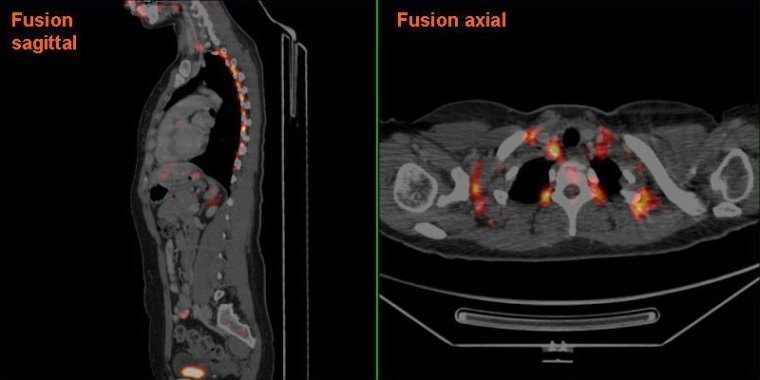| Health / Health News |
Study in mice suggests drug to turn fat ‘brown’ could help fight obesity
Our bodies contain two types of fat: white fat and brown fat. While white fat stores calories, brown fat burns energy and could help us lose weight. Now, scientists at the University of Cambridge have found a way of making the white fat ‘browner’ and increasing the efficiency of brown fat.

Brown adipose tissue in a woman shown in a PET/CT exam. ![]()
Both brown and white fat are made up of fat cells known as adipocytes, but in brown fat, these cells are rich in mitochondria – the ‘batteries’ that power our bodies – which give the tissue its brown colour. Brown fat also contains more blood vessels to allow the body to provide it with oxygen and nutrients.
While white fat stories energy, brown fat burns it in a process known as ‘thermogenesis’. When fully activated, just 100g of brown fat can burn 3,400 calories a day – significantly higher than most people’s daily food intake and more than enough to fight obesity.
We all have some brown fat – or brown adipose tissue, as it is also known – in our bodies, but it is found most abundantly in newborns and in hibernating animals (where the heat produced by brown fat enables them to survive even in freezing temperatures). As we age, the amount of brown fat in our bodies decreases.
Just having more brown fat alone is not enough - the tissue also needs to be activated. Currently, the only ways to activate brown fat are to put people in the cold to mimic hibernation, which is both impractical and unpleasant, or to treat them with drugs known as adrenergic agonists, but these can cause heart attacks. It is also necessary to increase the number of blood vessels in the tissue to carry nutrients to the fat cells and the number of nerve cells to allow the brain to ‘switch on’ the tissue.
In 2012, a team identified a molecule known as BMP8b that regulates the activation of brown fat in both the brain and the body’s tissues. They showed that deleting the gene in mice that produces this protein stopped brown fat from functioning.
Now, Professor Vidal-Puig has led an international team of researchers which has shown that increasing how much BMP8b mice can produce increases the function of their brown fat. This implies that BMP8b, which is found in the blood, could potentially be used as a drug to increase the amount of brown fat amount in humans as well as making it more active.
They found that increasing BMP8b levels changed some of the white fat into brown fat, a process known as beiging and thus increased the amount of energy burnt by the tissue.
Higher levels of BMP8b make the tissue more sensitive to adrenergic signals from nerves – the same pathway target by adrenergic agonist drugs. This may allow lower doses of these drugs to be used to activate brown fat in people, hence reducing their risk of heart attack.
Unexpectedly, but importantly, the team also found that the molecule increased the amount of blood vessels and nerves in brown fat. (University of Cambridge)
YOU MAY ALSO LIKE


